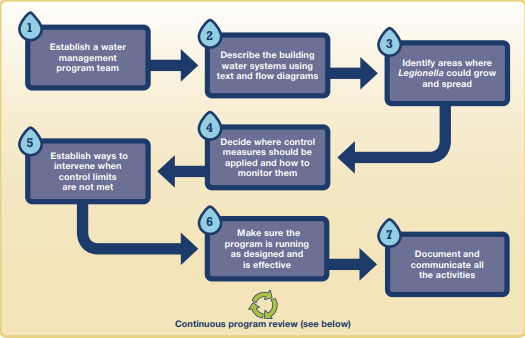New Requirements for Hospitals and Nursing Homes Regarding Legionella Bacteria
Recent Amendments to Illinois House Bill 158
The new amendments added to Section 90-10 of The Hospital Licensing Act and Section 90-5 of the Nursing Care Act have made it a requirement for nursing homes and hospitals to test their water systems in accordance with a written policy which states the testing frequency and provides results upon request. As a result, hospitals and nursing home facilities must develop water quality management plans and test their water systems and cooling towers throughout the year.
Developing a Water Management Plan
A good resource to consider when creating a water management plan is, “Developing a Water Management Program to Reduce Legionella Growth & Spread in Buildings: A Practical Guide to Implementing Industry Standards”4 developed by the CDC. The document details Legionella bacteria, where it can be found within buildings, control measures, corrective actions and much more.
One major element of a water management plan is using an industry professional to execute testing. If laboratory results show elevated levels of Legionella, the water management plan should cover remediation measures to decrease bacteria concentrations within the water system. After the system is flushed, it is important to retest to ensure Legionella levels are below industry guidelines.

The Next Step for Hospitals and Nursing Homes
If you are responsible for generating a water management plan for your hospital or nursing home, it can be daunting. Indoor Science has several certified industrial hygienists to advise on testing frequency, remediation measures, execute testing, plan development, communication strategies or many other areas of support. If you have questions or are in need of water quality testing at your facility, please contact us at (312) 920-9393 for assistance.
Why should we be Concerned about Legionella Bacteria?
Legionella is a gram-negative bacteria found naturally throughout the world. There are over 40 known species of Legionella.1 If building occupants inhale the airborne bacteria, they can contract a deadly disease called Legionnaires Disease which is similar to pneumonia. The Center of Disease Control (CDC) estimates that approximately 10,000 individuals each year are hospitalized with Legionnaires’ disease in the United States.3 On average, every 1 in 10 people who contract the disease will die.3 If the bacteria is ingested, the individual can contract a disease called Pontiac Fever which is a flu-like illness.
Since Legionella is most frequently found in aquatic habitats, it therefore can contaminant buildings’ water systems, plumbing and cooling towers. These areas need to be periodically tested and treated to ensure the bacteria is not exposed to building occupants. This is particularly important when the building is occupied by individuals who may be more vulnerable to contracting the diseases associated with the bacteria, like hospitals and nursing homes.
- United States Environmental Protection Agency. (2000, September). Legionella: Drinking water fact sheet. LEGIONELLA: DRINKING WATER FACT SHEET. Retrieved May 17, 2022, from https://www.epa.gov/sites/default/files/2015-10/documents/legionella-factsheet.pdf
- Barskey, A. (2020, January 13). Legionnaires’ disease surveillance reports 2016-2017. Centers for Disease Control and Prevention. Retrieved May 17, 2022, from https://www.cdc.gov/legionella/health-depts/surv-reporting/2016-17-report-tables/index.html
- Centers for Disease Control and Prevention. (2021, March 25). Legionnaires disease, Pontiac fever fast facts. Centers for Disease Control and Prevention. Retrieved May 17, 2022, from https://www.cdc.gov/legionella/fastfacts.html
- CDC. (2021, June 24). Developing a water management program to reduce legionella growth … Retrieved May 17, 2022, from https://www.cdc.gov/legionella/downloads/toolkit.pdf
 877-872-4339
877-872-4339  Contact Us
Contact Us 






